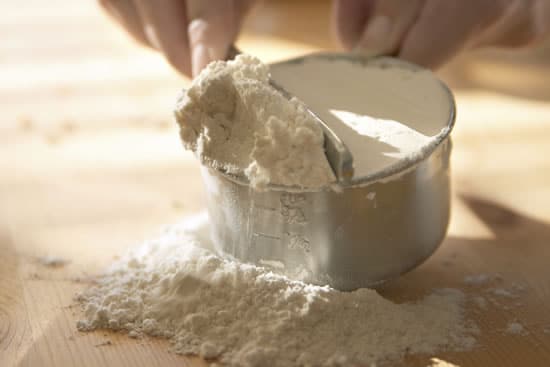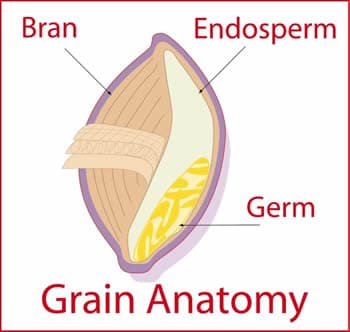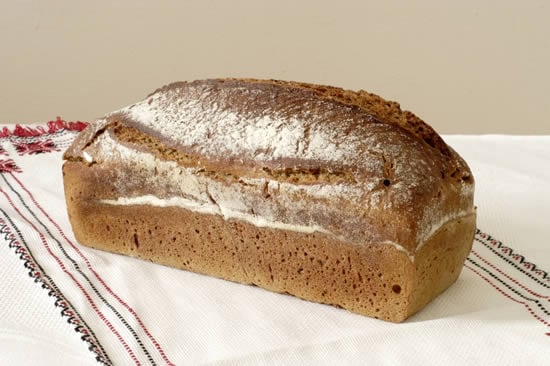The Scoop on White Flour (100% Whole Wheat Bread)
Oct 11, 2011, Updated Oct 03, 2017

White Flour is, at the same time, one of the most coveted ingredients for baking in the world and the nemesis of health-conscious eaters everywhere. White flour is the ever-present ingredient in processed foods and, probably, the single most consumed processed food in the United States (although high fructose corn syrup might give it a run for its money). Andrew asked me to explain how white flour is made, why it might be bleached and enriched, and why whole grains are a far superior choice for your health.
First, a short history lesson
What’s the deal with white flour anyway? How did we end up eating solely nutritionally deplete flour? White flour first appeared in appreciable quantity in the late 1800s with the industrial revolution. Whole wheat flour has a short shelf life; after all, it contains the germ and bran which can cause rancidity. Steam mills came with the age of industry, allowing a lot of flour to be produced quickly and transported all over the country. At the time, “flour” meant whole wheat flour, which will last only about 6 to 9 months before spoiling. To solve this short shelf life problem, millers began sifting out the germ and bran to increase the life for their flour.
In the beginning, white flour was a food of the elite. It was consumed by those with money and those in urban areas. As industry made it cheaper to produce, it became cheaper to buy. Lower income consumers imitated the wealthy and, within a few short years, white flour was the standard for everyone.
Milling
If you know that white flour is made from wheat, you’re one step ahead of a lot of people — truly, I’m not joking. White flour is made by separating the bran and the germ from the endosperm of the grain of wheat. That’s not really as complicated as it sounds — it is simply ground (typically on a high-speed, steel roller mill) and sifted to remove the fluffy white from the heavier brown. The sifting repeats until all that is left is white, fluffy flour. Fine flours, such as cake flour, are sifted more heavily. For a more in-depth description, check out this awesome video from Discovery: How It’s Made Flour.
Bleaching, Bromating, and Enriching
Often you see two types of white flour — unbleached and bleached. Bleaching is done quite simply to make flour that is truly white. Without it, white flour has a slightly off-white color. When white flour was hitting its peak, bleaching was popular to make the whitest cakes and whitest bread possible. While bleaching has become far less popular, it can still be found in many large flour brands and in most processed food.
Potassium Bromate is an enrichment added to help develop the gluten (protein) in baking. It strengthens the dough and encourages rising. Most manufacturers of flour no longer use this enrichment because research has indicated it to be a carcinogen. While it is outright banned in the United Kingdom, the FDA has not banned bromate from use in the United States, though they strongly discourage bakers from using it. Today, most manufacturers of white flour add Malted Barley Flour to bolster their flour. Malted Barley Flour is quite simply barley that has been sprouted, dried and ground into flour.
Other enrichments required by law for conventional white flour include folic acid, niacin, iron, thiamin and riboflavin. These vitamins were originally required by law (circa 1940) to help solve health issues caused by diets deficient in these essential nutrients. These nutrients are naturally found in whole wheat flour and are removed when the germ and bran are removed. Funny, isn’t it? That the government requires us to add enrichment to flour that would have been just fine had it been left whole. With so many Americans relying on white flour, though, it was necessary to help prevent things like neural tube defects in unborn babies.
In the United States, you cannot enrich organic flours — so if you want to skip the added vitamins, go organic. Alternately, in Canada all white flour must be enriched — regardless of its organic status.
Go whole grain, but know before you buy
Many of the giant flour manufacturers in the United States do not grind whole wheat flour from the whole grain. Instead, they separate all three parts of the wheat grain and re-combine them to produce whole wheat flour. It’s far cheaper to produce this way because the majority of their business is in white flour. This is completely legal in the United States and qualifies to be called whole grain. Investigate the source of your whole wheat flour before you buy.
That’s the short version of a very long story about how America became reliant on enriched white flour. For your good health, start switching to whole grain flours such as whole wheat and spelt in your baked goods, choose pasta made with whole wheat flour and pick brown rice over white rice. The nutrients naturally found in whole grains make enrichment unnecessary. Whole grains are packed with fiber and offer variety in flavor and texture. A cookie made with whole wheat pastry flour tastes as good, if not better, than one made with white flour and your conscience can rest easy knowing you fed your family something healthier.

100% Whole Wheat Bread
Ingredients
- 2 Tbsp Active Dry Yeast
- 1/4 cup Warm Water, 110 degrees
- 1/4 cup Honey, + 2 Tbsp
- 1-1/2 tsp Sea Salt
- 3 Tbsp Oil*
- 1-3/4 cups Warm Water, 110 degrees
- 6 cups Stone-Ground Whole Wheat Flour
Instructions
- Dissolve yeast in 1/4 cup warm water. Allow to proof 3-5 minutes.
- Combine next 4 ingredients and add to yeast mixture.
- Stir in flour, mix well. Knead 10 minutes. Let rise 1 hour and 45 minutes.
- Punch down. Let rise 40-60 minutes until doubled.
- Punch down and let rise a third time until doubled.
- Shape into 2 loaves and let rise until doubled.
- Preheat oven to 350 degrees Fahrenheit. Bake for 45 minutes.























ive been reading a ton of info recently about how whole grain wheat bread can spike blood sugar just as regular white bread. this is due to the grains being ground so finely that the surface area is incredibly easy to break down and convert to sugars. im cuious of your thoughts on this. ive noticed after cutting out as much wheat as possible form my diet that i have less headaches, i feel less sluggish, etc etc. ive been replacing it with sprouted grain [millet,spelt] bread.
I’m not going to argue with your reduction in headaches – if it works for you, it works. 🙂
However: 1. whole-wheat flour, however finely ground, still has the fiber in it, so it reasonably shouldn’t give you refined-sugar, white-flour type bloodsugar spikes, but might be somewhere in between white flour and an unmilled grain like, for example, brown rice or whole oats. 2. you might have a wheat-allergy (not necessarily celiac [especially if spelt gives you no trouble] – there are other things in wheat that some people are sensitive to, besides the gluten). I’m NOT an allergist; if you have insurance and/or funds, it might be worthwhile to get tested.
Rachel-
Yes, just add the liquid ingredients to your bread machine, then the dry (except yeast). Make a well in the dry ingredients and put in the yeast. Then, use the whole grain bread setting or basic bread setting and you should be set.
Can you do this recipe in a bread machine?
Thanks for this great recipe! I did a half recipe for 1 loaf. I used coconut oil, local honey, and Bob’s redmill yeast. The twist was that I only had 2 cups of whole wheat flour so the last cup was whole wheat *pastry* flour (I was sure this was going to screw it all up but it turned out great!). I was very impressed with how much it rose and how good it is! I like my whole wheat bread sweeter and will add extra honey next time.
Jennifer- I am not sure if the larger companies would reveal that info. I would hope that they would. One thing to look for would be to find out exactly what kind of milling they do- if they make their own flour, how it’s made (stone ground, steel mills), etc. Because it’s ok to call it whole wheat flour even if it’s separated, it might be hard to find out on the big companies. I’m sure King Arthur, Hodgson Mills, and Arrowhead Mills, would be more open about their practices than, say, General Mills or Pillsbury. Look for stone ground- it’s the most likely to be ground from whole grains.
Sarah: Yes, it would work just fine with white whole wheat flour- our brand or KA.
Thank you! I use Bob’s all the time to make gluten-free goodies for my mom, but will def be checking out the whole wheat flour, too. I just have KAF on hand right now!
Many thanks for a VERY enlightening history lesson! I am a native Oregonian and I will be delighted to support Bob’s Red Mill with my grocery dollars from now on. Thankfully there ARE food product companies that run their businesses with integrity and profitability. It can be done. I will watch for more recipes!
Thanks for the great info and recipe! Do you think it would work using white whole wheat flour (KAF)? Thanks!
Yes, the reconstituted whole wheat is crazy! It’s amazing to see what companies are getting away with when it comes their labeling. I can’t wait to try out this recipe.
I had no idea about the reconstituted whole week. That is crazy. But I guess not totally surprising. Time to do more research.
Wow, so awesome to know…I knew about half of it, but glad to know “the rest of the story…”. Thanks for sharing, I am sharing it on FB with my friends, as I am about to bake some sourdough from my started, courtesy of “Pinch My Salt” blog.